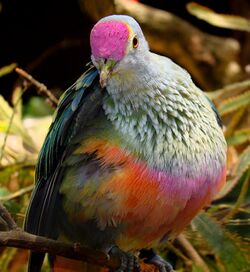Biology:Rose-crowned fruit dove
| Rose-crowned fruit dove | |
|---|---|

| |
| Scientific classification | |
| Domain: | Eukaryota |
| Kingdom: | Animalia |
| Phylum: | Chordata |
| Class: | Aves |
| Order: | Columbiformes |
| Family: | Columbidae |
| Genus: | Ptilinopus |
| Species: | P. regina
|
| Binomial name | |
| Ptilinopus regina Swainson, 1825
| |
The rose-crowned fruit dove (Ptilinopus regina), also known as pink-capped fruit dove or Swainson's fruit dove, is a medium-sized fruit dove that is found in parts of southern Indonesia, northern Australia and eastern Australia.
Taxonomy
The rose-crowned fruit dove was formally described in 1825 by the English naturalist William Swainson. He considered his specimens as a variant of the grey-green fruit dove (Ptilinopus purpuratus) and specified the scientifc name as Ptilinopus purpuratus var. Regina. [2] The type locality is New South Wales.[3]
Five subspecies are recognised:[4]
- P. r. flavicollis Bonaparte, 1855 – Flores, Savu, Rote, Semau and west Timor (central Lesser Sunda Islands)
- P. r. roseipileum Hartert, EJO, 1904 – east Timor, Wetar, Romang, Kisar, Leti and Moa (east Lesser Sunda Islands)
- P. r. xanthogaster (Wagler, 1827) – Damar Island, Sermata, Nila, Teun and Babar Islands (far east Lesser Sunda Islands), Banda, Kai and Tanimbar Islands (south Moluccas) and Aru Islands (southwest of New Guinea)
- P. r. ewingii Gould, 1842 – northeast Western Australia to northeast Northern Territory and Melville Island (Tiwi Islands, north of Northern Territory; north Australia)
- P. r. regina Swainson, 1825 – Torres Strait islands, north Cape York Peninsula, northeast Queensland to southeast New South Wales (far northeast to southeast Australia)
Description
The rose-crowned fruit dove is 22 cm (8.7 in) long and has a grey head and breast, an orange belly, whitish throat, yellow-orange iris, and greyish green bill and feet. It has a pinkish-red crown with yellow border. The Indonesian subspecies, P. r. xanthogaster, has a whitish crown and paler grey head and breast. Both sexes are similar. The young has a green-colored crown and plumage.
Distribution and habitat
The rose-crowned fruit dove is distributed in lowland rainforests of northern and eastern Australia , and monsoon forests of northern Australia, Lesser Sunda Islands and Maluku Islands of Indonesia. The diet consists mainly of various fruits, palms and vines. The female usually lays a single white egg.
Widespread and common throughout its large range, the rose-crowned fruit dove is evaluated as Least Concern on the IUCN Red List of Threatened Species.
References
- ↑ BirdLife International (2016). "Ptilinopus regina". IUCN Red List of Threatened Species 2016: e.T22691430A93312183. doi:10.2305/IUCN.UK.2016-3.RLTS.T22691430A93312183.en. https://www.iucnredlist.org/species/22691430/93312183. Retrieved 12 November 2021.
- ↑ Swainson, William John (1825). "On the characters and natural affinities of several new birds from Australasia; including some observations on the Columbidae". Zoological Journal 1: 463-484 [474-476]. https://www.biodiversitylibrary.org/page/27571201.
- ↑ Peters, James Lee, ed (1937). Check-List of Birds of the World. 3. Cambridge, Massachusetts: Harvard University Press. p. 29. https://www.biodiversitylibrary.org/page/14477744.
- ↑ Gill, Frank; Donsker, David; Rasmussen, Pamela, eds (December 2023). "Pigeons". IOC World Bird List Version 14.1. International Ornithologists' Union. https://www.worldbirdnames.org/bow/pigeons/.
External links
Wikidata ☰ Q1585789 entry
 |


